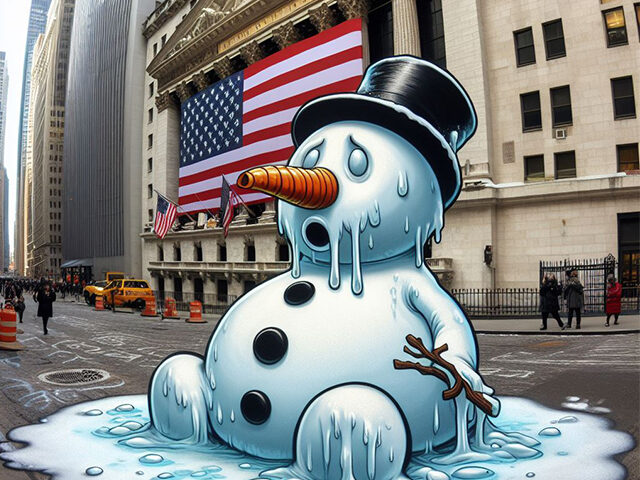Spoiler Alert: Frosty Melted
Financial markets are nestled, all snug in their rate-cut beds, while visions of expansive deflation dance in the traders’ heads.
The forecast for the economy seems merrier than a band of carolers on a snowy Christmas eve. Prices of stocks and bonds indicate a forecast that inflation will fall while the economy avoids a recession.
Santa’s elves, however, may have different plans. The Federal Reserve Bank of Atlanta’s GDPNow is currently indicating that the economy will expand at an annual rate of 2.7 percent in the fourth quarter, far faster than the one percent Wall Street is expecting.
The signs of an accelerating economy are hung by the chimney with care—if anyone would bother to look. Home builders are increasingly optimistic, with Monday’s survey showing the first increase in five months. Housing starts jumped much higher than expected, according to data released Tuesday.
As we explained yesterday, all the economic signals are flashing like Rudolph’s nose:
November retail sales smashed expectations. S&P Global’s purchasing managers surveys showed economic activity expanding at the fastest pace in five months. The money supply is no longer contracting. Gallup’s poll says consumers have increased the amount they plan to spend on holidays as the shopping season has progressed.
It’s fun to play with Frosty the Snowman, but eventually he melts.
Mirror, Mirror on the Wall
The Fed is facing a reflexivity problem. The more financial markets accept the view of central bankers that the economy will expand next year while inflation contracts, the less likely that becomes. The easing of financial conditions that rising stocks and falling Treasury yields represents points to more inflation and faster growth.
The economy grew at a 5.2 percent pace in the third quarter. If it were slowing to a one percent pace in the fourth quarter, you would expect that to be noticeable. Instead, anecdotal evidence indicates that restaurants and shopping malls are packed. S&P Global’s survey of purchasing managers indicates a vigorous surge in demand in the services sector.
Here’s Chris Williamson, the chief business economist at S&P Global:
The early PMI data indicate that the US economy picked up a little momentum in December, closing off the year with the fastest growth recorded since July.
Looser financial conditions have helped boost demand, business activity and employment in the service sector, and have also helped lift future output expectations higher. However, the increased cost of living and cautious approach to spending by households and businesses means the overall rate of service sector growth remains far short of that witnessed during the travel and leisure revival back in the spring and summer.
To be sure, the manufacturing sector is a drag, but perhaps not as much as expected. The end of UAW strike boosted industrial production in November, and stronger-than-expected holiday sales may lift orders.
The election year is unlikely to bring any fiscal austerity. Both parties are incentivized to declare themselves against spending cuts, especially when it comes to entitlement programs such as Social Security or Medicare.
Bank of America’s analysts point out that it is unlikely that the now dead Fed rate hiking cycle is going to weigh on the economy in 2024:
In 2023, locked-in low mortgage rates kept housing strong in spite of Fed hikes. In 2024, strong wage growth, government spending, and corporate dry powder could keep the economy stronger than expected. These areas look insulated from or even impervious to Fed hikes.
Premature or aggressive Fed cuts could reignite price pressures, we believe.
Bank of America analysts state even more bluntly: “Fed hikes do not stop Congress. Most of the stimulus authorized in the past three years has yet to be spent and capacity utilization in the economy is already at decade-highs.”
The Fed’s forecast is for the economy to grow at a modest 1.4 percent pace next year. If it grows faster than that—which seems likely given the recent signs of acceleration—its forecast of three cuts next year will likely be wrong as well. That will make Wall Street’s expectation of five, six, or seven cuts even more painful.

COMMENTS
Please let us know if you're having issues with commenting.